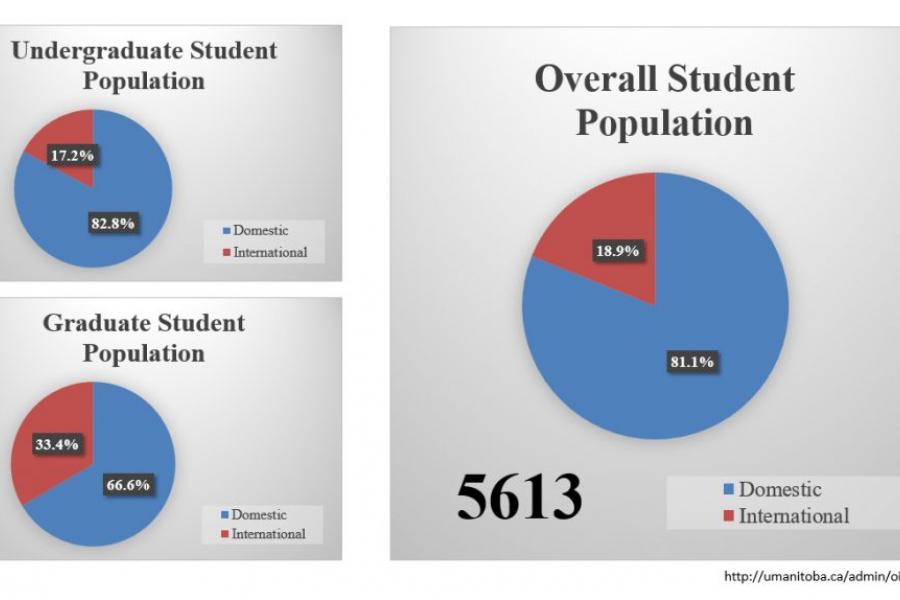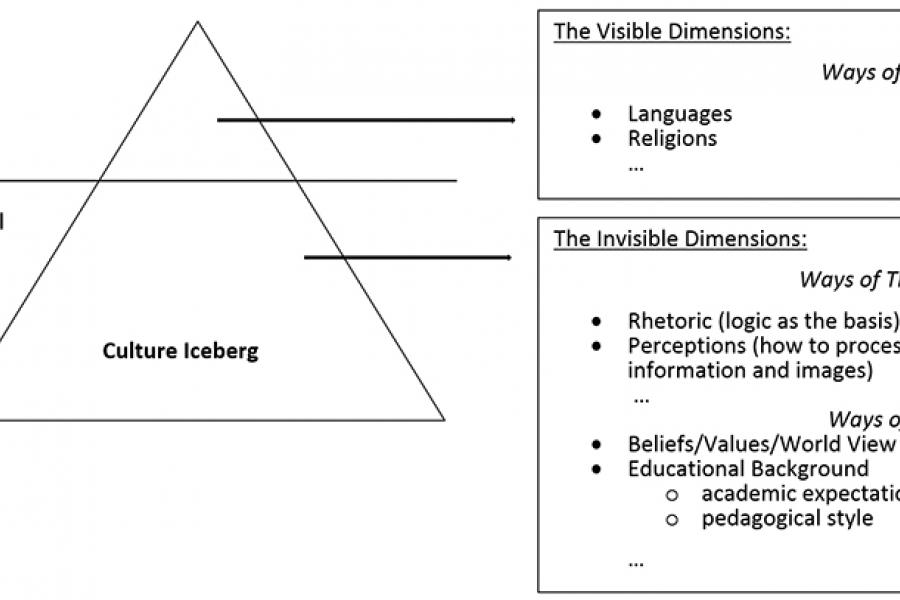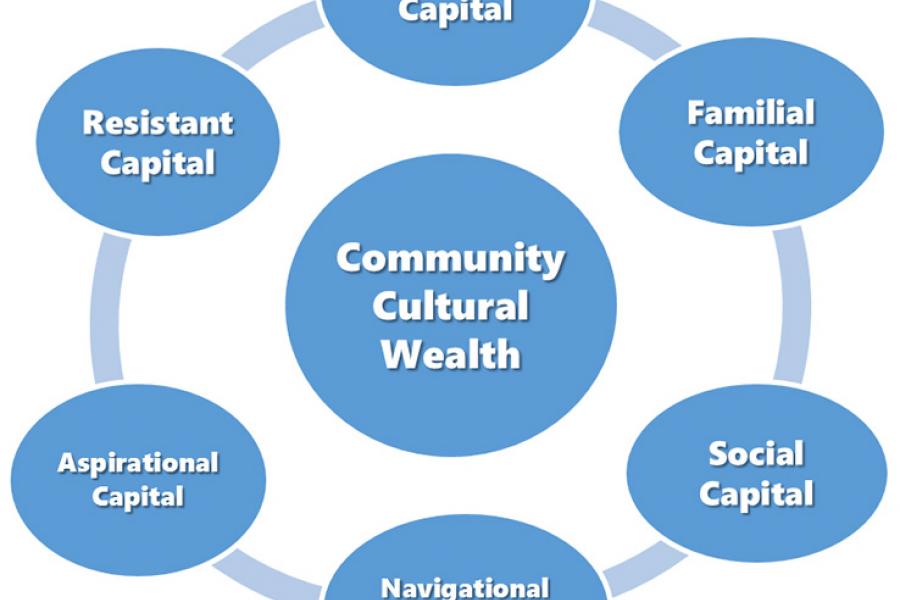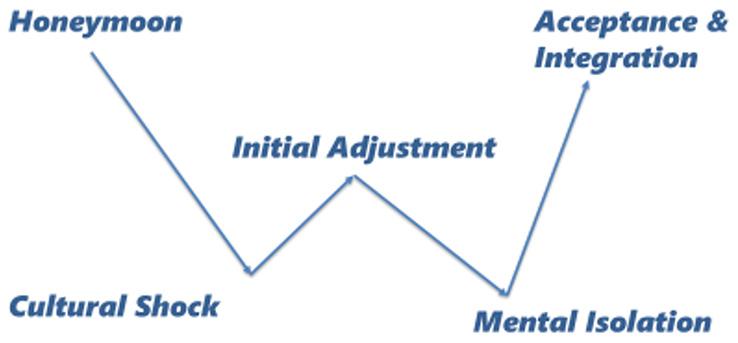Prepare to teach international students
As instructors, it is important that we are aware of struggles international students can face and adopt strategies that will support international students.

Introduction
In the fall term of 2018, there were 5613 international students registered at the University of Manitoba. This represents 18.9% of the total student population. Clearly, international students represent a significant part of our student population. However, the challenges that international students face are many. As instructors, it is important that we become aware of these struggles and adopt strategies that will support our international students.

Getting to know international students
International students are a population from diverse cultural, educational, economic, social, political, and linguistic backgrounds and should not be characterized as a homogenous group1.
Culture Iceberg Model
Think of culture as an iceberg. There are elements that are visible, such as languages, religion, clothing, and so on. However, most of what makes up a culture is invisible – perceptions, beliefs, values, etc.2.

Cultural diversity matters in teaching and learning
Based on the culture iceberg model, students from diverse cultural backgrounds may hold a very different understanding towards teaching and learning. Their expectation of what to learn and how to learn is “coloured by past experience”3 (p49) thus may not necessarily be in line with our expectation. Therefore, we should always take into account the gap in beliefs and expectations of education to avoid making our international students feel ignored, excluded or marginalized in class4.
The website below provides a snapshot of cultural backgrounds and educational rules of most countries in the world. Please use the website for general reference only in order to avoid stereotyping of your students, as they are also dynamic individuals.
Hofstede’s cultural dimensions
International students are commonly perceived as deficient as they seem to lack critical thinking skills and are often unwilling to participate in group activities1. As mentioned in the previous section, how students (both domestic and international) perform in class is based on their previous educational experience and beliefs in what means to learn.
Hofstede’s Cultural Dimensions attempts to explain some international students’ academic behaviors and their relationships with instructors and peers.
| Individualism vs. Collectivism5,6 | |
|
Individualism The squeaky wheel gets the grease.
|
Collectivism The nail standing out gets pounded down.
|
| Power Distance5,6 | |
|
Small Power Distance Equity in society, respect for all people regardless of position.
|
Large Power Distance Heirarchy in society, emphasis on titles and roles
|
ith the understanding of these cultural dimensions, we may see that if an international student is from a collective society with large power distance, they may not have much experience in speaking their mind in class or participating in various learning activities. Additionally, these dimensions can explain why international students relate to their instructors and peers in certain ways. They may consider their instructors or even domestic peers as authorities in class as they believe that hierarchy is based on a variety of factors such as length of membership of the group, skills, experience, knowledge, social class, race and language proficiency7.
Consequently, both academics and students may come to see that “difference is not deficit”8 (p2). It is important that we, as educators, do not stereotype international students or devalue their previous academic experience and cultural background. By spending time and getting to know our international students, we may help them adapt their academic expectations and learning styles.
International students’ challenges
Yosso’s Community Cultural Wealth Framework9 (p78) provides a clear view of what kind of challenges international students may encounter while studying in our university. There are six types of capital included in the framework and each impacts international students’ academic study.

Yosso’s Community Cultural Wealth Framework – Details
The Gullahorn “W Curve” Transition Model14
In transition into the new learning environment, international students may go through different stages as indicated below:
Here is the detailed explanation of each phase14:
Honeymoon Phase – When students first arrive in a new culture they experience a feeling of excitement as everything seems fresh and different.
Cultural Shock – When the initial excitement fades, international students feel insecure or confused in the new culture. They struggle while trying to understand the norms and regulations and start to miss their family and the support they used to have.
Initial Adjustment – International students begin to successfully manage many of the issues they faced during culture shock stage. They feel more “at home” in the new environment. Generally speaking, extroverts often reach this stage quicker than introverts.
Mental Isolation – After international students come back from visiting home for an extended period of time, strong feelings of homesickness begin to arise or re-arise. They often feel like they are caught between two worlds. Life in the new country is still not as comfortable as home used to be and home is now not as familiar as it once was.
Acceptance and Integration – In this stage, international students have grown a feeling of self-assurance and a more complete understanding of their own culture and the new culture. They start to value the differences and similarities and feel confident about handling most situations in the new environment.
Not everyone will go through all the stages of the W-curve and different individuals may experience different lengths of time at each stage. It may take some international students at least a semester to eventually settle in, while for others it may take an entire academic year or even longer14.
Therefore, It is important to provide international students with not only academic assistance, but also emotional and social support during their time of transition. Positive encounters with instructors, although generally short, contribute to the development of international students’ transition15.
Teaching resources
YouTube Video: Cultures of learning – vital feature of international education https://www.youtube.com/watch?v=6LsZ_-wp0nA
YouTube Video: Strategies for Teaching Culturally Diverse Students https://www.youtube.com/watch?v=tPutaPc9gB8
The University of Bedfordshire. (2015, January). A Guide to Teaching International Students. Retrieved January 30, 2017, from:https://www.beds.ac.uk/__data/assets/pdf_file/0005/273767/UoB-14-Guide-to-Teaching-International-Students-Jan-15.pdf
Understand Cultural/Academic/Linguistic Shock
http://www.ukcisa.org.uk/Information–Advice/Preparation-and-Arrival/Facing-culture-shock
References
- Ryan, J. & Viete, R. (2009). Respectful interactions: learning with international students in the English-speaking academy. Teaching in Higher Education, 14 (3), 303-314.
- Storti, L. & Bennhold-Samaan. (1997) Culture matters: The Peace Corps cross-cultural workbook. Peace Corps Information Collection and Exchange, Washington, DC. Retrieved from: Peace Corps | World Wise Schools | Teaching About Culture | Culture Matters Workbook
- McLean, P. and Ransom, L. (2005) Building intercultural competencies: Implications for academic skills Development. In Teaching International Students: improving learning for all, ed. Carroll, J and Ryan, J New York: Routledge, pp 45-62.
- Guo, S., & Jamal, Z. (2007). Nurturing cultural diversity in higher education: A critical review of selected models. Canadian Journal of Higher Education, 37 (3), 27-49.
- Schmitt, D. (2005). Writing in the international classroom. In Teaching international students: Improving learning for all, ed. J. Carroll and J. Ryan. New York: Routledge. Teaching International Students | Improving Learning for All | Jude Ca
- Hofstede, G. & Hofstede, G. J. (2005). Cultures and Organizations: Software of the Mind (Rev. 2nd ed.). New York: McGraw-Hill. For translations see www.geerthofstede.nl and “our books
- Scudamore, R., & Bond, K. (2010). Working with International Students: a Guide for Staff in Engineering. Retrieved June 2017 from: https://www.heacademy.ac.uk/system/files/working-with-international-students.pdf
- Centre for Learning Excellence. (2015). A Guide to teaching international students. University of Bedfordshire. Retrieved June, 2017 from: https://www.beds.ac.uk/__data/assets/pdf_file/0005/273767/UoB-14-Guide-to-Teaching-International-Students-Jan-15.pdf
- Yosso, T. J. (2005). Whose culture has capital? Race, Ethnicity and Education, 8 (1), 69‐91. Retrieved June, 2017 from: https://www.researchgate.net/publication/345529518_Whose_Culture_Has_Capital
- Jung, E. (2014). International Graduate Students’ Perceptions of Academic Learning. University of Manitoba. Retrieved June, 2017 from: https://mspace.lib.umanitoba.ca/bitstream/handle/1993/23606/Jung_Erica.pdf?sequence=1
- Locks, A. (n.d.). Summary of Yosso’s cultural wealth model. Retrieved June 2017 from: http://web.csulb.edu/divisions/aa/personnel/fcpd/workshops/documents/Wrk1EditedYossoCulturalWealthSummary.pdf
- Alexander, H. (2007). Unis open to students who fail English tests. Sydney Morning Herald, January 29.
- Williams, S. (2008). Internationalization of the Curriculum: A Remedy for International Students’ Academic Adjustment Difficulties? Memorial University of Newfoundland. Retrieved June, 2017 from: http://web.uvic.ca/~sherriw/images/ED%206890%20Sherri%20Williams%20Final%20Paper%20for%20website.pdf
- Hoffenburger, K., Mosier, R., & Stokes, B. (1999). Transition experience. In J.H. Schuh (Ed.), Educational programming and student learning in college and university residence halls. Columbus, OH.
- Glass, C., Wongtrirat, R., & Buus, S. (2014). International student engagement: Strategies for creating inclusive, connected and purposeful campus environments. Sterling, VA: Stylus Publishing.

